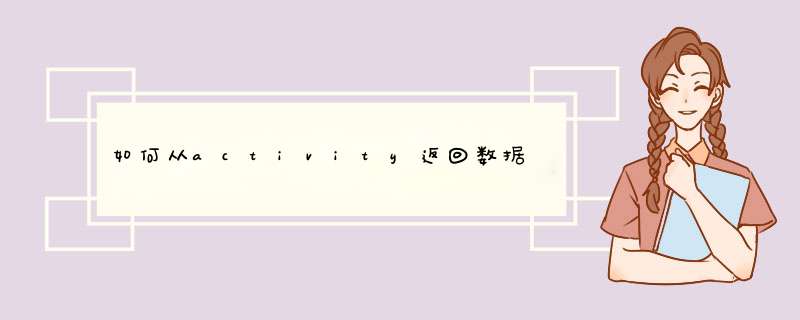
1、在实际应用中,我们不仅要向Activity中传数据,也要从Activity中返回数据。虽然传递数据和返回数据类似,也可以采用前面四篇中提到的4种方法,但是一般建议采用Intent对象的方式来返回数据,使用这种方式返回数据,需要使用startActivityForResult方法来显示Activity;
2、新建Android项目“android_intent_forresult”,打开布局文件“activity_mainxml”,添加“LinearLayout”、“TextView”、“EditView”等标签,代码如下:
<LinearLayout xmlns:android=">
android:layout_width="fill_parent"
android:layout_height="fill_parent"
android:orientation="vertical" >
<LinearLayout
android:layout_width="fill_parent"
android:layout_height="wrap_content"
android:orientation="horizontal" >
<EditText
android:id="@+id/one"
android:layout_width="20dp"
android:layout_height="wrap_content" >
</EditText>
<TextView
android:layout_width="wrap_content"
android:layout_height="wrap_content"
android:text=" + " >
</TextView>
<EditText
android:id="@+id/two"
android:layout_width="20dp"
android:layout_height="wrap_content" >
</EditText>
<TextView
android:layout_width="wrap_content"
android:layout_height="wrap_content"
android:text=" = " >
</TextView>
<EditText
android:id="@+id/result"
android:layout_width="20dp"
android:layout_height="wrap_content" >
</EditText>
</LinearLayout>
<Button
android:id="@+id/button"
android:layout_width="fill_parent"
android:layout_height="wrap_content"
android:text="计算结果" >
</Button>
</LinearLayout>
3、新建布局文件“otherxml”,添加“TextView”、“EditView”、“Button”标签,代码如下:
<xml version="10" encoding="utf-8">
<LinearLayout xmlns:android=">
4、新建“OtherActivityjava”文件,并使其继承“Activity”,添加“onCreate”方法,代码如下:package comandroidmyintent;
import androidappActivity;
import androidosBundle;
public class OtherActivity extends Activity {
@Override
protected void onCreate(Bundle savedInstanceState) {
// TODO Auto-generated method stub
superonCreate(savedInstanceState);
setContentView(Rlayoutother);
}
}
5、在“AndroidManifestxml”清单文件中加入“Activity”,加入代码:<activity android:name="OtherActivity" >
</activity>
6、在“Mainjava”中添加Button成员和“setOnClickListener”,实现两个Button的跳转,点击第一个Activity后,出现第二个Activity;在此方法内部创建意图,用“startActivityForResult”启动意图,并在Main类里重写“onActivityResult”;添加“EditText”成员,实现数据的输入并传入Intent中。代码如下:
package comandroidmyintent;
import androidRinteger;
import androidosBundle;
import androidappActivity;
import androidcontentIntent;
import androidviewMenu;
import androidviewView;
import androidwidgetButton;
import androidwidgetEditText;
public class Main extends Activity {
private Button button;
private final static int REQUESTCODE = 1;// 表示返回的结果码
private EditText one, two, result; // 数据输入
@Override
protected void onCreate(Bundle savedInstanceState) {
superonCreate(savedInstanceState);
setContentView(Rlayoutactivity_main);
one = (EditText) thisfindViewById(Ridone);
two = (EditText) thisfindViewById(Ridtwo);
result = (EditText) thisfindViewById(Ridresult);
button = (Button) thisfindViewById(Ridbutton);
buttonsetOnClickListener(new ViewOnClickListener() {
@Override
public void onClick(View arg0) {
// TODO Auto-generated method stub
// 点击后获得用户录入的值
int a = IntegerparseInt(onegetText()toString());
int b = IntegerparseInt(twogetText()toString());
// 创建意图
Intent intent = new Intent(Mainthis, OtherActivityclass);
// 将值传入意图
intentputExtra("a", a);
intentputExtra("b", b);
startActivityForResult(intent, REQUESTCODE);// 表示可以返回结果
}
});
}
// 再重写一个onActivityResult方法,作用是将当前Activity中的数据传递到另一个Activity的意图中后,实现跳转,再回传回来。
@Override
protected void onActivityResult(int requestCode, int resultCode, Intent data) {
// TODO Auto-generated method stub
superonActivityResult(requestCode, resultCode, data);
}
@Override
public boolean onCreateOptionsMenu(Menu menu) {
// Inflate the menu; this adds items to the action bar if it is present
getMenuInflater()inflate(Rmenumain, menu);
return true;
}
}
7、在“OtherActivityjava”文件中添加Button和TextView成员,获取意图中的数据,代码如下:package comandroidmyintent;
import androidappActivity;
import androidcontentIntent;
import androidosBundle;
import androidwidgetButton;
import androidwidgetTextView;
public class OtherActivity extends Activity {
private Button button;
private TextView textView;
@Override
protected void onCreate(Bundle savedInstanceState) {
// TODO Auto-generated method stub
superonCreate(savedInstanceState);
setContentView(Rlayoutother);
// 实例化button和textview
button = (Button) thisfindViewById(Ridbutton2);
textView = (TextView) thisfindViewById(Ridmsg);
Intent intent = getIntent(); // 获取Intent
// 取出Intent中的值
int a = intentgetIntExtra("a", 0);
int b = intentgetIntExtra("b", 0);
textViewsetText(a + " + " + b + " = " + " ");
}
}
运行一下,看下效果:
点击“计算结果”,跳转到第二个Activity:
8、回到“Mainjava”文件中,从OtherActivity中获取数据并显示,代码如下:
package comandroidmyintent;
import androidRinteger;
import androidosBundle;
import androidappActivity;
import androidcontentIntent;
import androidviewMenu;
import androidviewView;
import androidwidgetButton;
import androidwidgetEditText;
public class Main extends Activity {
private Button button;
private final static int REQUESTCODE = 1;// 表示返回的结果码
private EditText one, two, result; // 数据输入
@Override
protected void onCreate(Bundle savedInstanceState) {
superonCreate(savedInstanceState);
setContentView(Rlayoutactivity_main);
one = (EditText) thisfindViewById(Ridone);
two = (EditText) thisfindViewById(Ridtwo);
result = (EditText) thisfindViewById(Ridresult);
button = (Button) thisfindViewById(Ridbutton);
buttonsetOnClickListener(new ViewOnClickListener() {
@Override
public void onClick(View arg0) {
// TODO Auto-generated method stub
// 点击后获得用户录入的值
int a = IntegerparseInt(onegetText()toString());
int b = IntegerparseInt(twogetText()toString());
// 创建意图
Intent intent = new Intent(Mainthis, OtherActivityclass);
// 将值传入意图
intentputExtra("a", a);
intentputExtra("b", b);
startActivityForResult(intent, REQUESTCODE);// 表示可以返回结果
}
});
}
// 再重写一个onActivityResult方法,作用是将当前Activity中的数据传递到另一个Activity的意图中后,实现跳转,再回传回来。
@Override
protected void onActivityResult(int requestCode, int resultCode, Intent data) {
// TODO Auto-generated method stub
superonActivityResult(requestCode, resultCode, data);
if (resultCode == 2) {// 如果第二个Activity(OtherActivity)正常结束(“2”为返回码resultCode)。
if (requestCode == REQUESTCODE) {// 如果返回状态为1,即成功返回,就在意图的返回值中取出数据。
int three = datagetIntExtra("three", 0);// 从第二个Activity中返回意图中的数据。
resultsetText(StringvalueOf(three));
}
}
}
@Override
public boolean onCreateOptionsMenu(Menu menu) {
// Inflate the menu; this adds items to the action bar if it is present
getMenuInflater()inflate(Rmenumain, menu);
return true;
}
}
9、在“OtherActivityjava”文件中,添加点击Button事件,使数据回传~,代码如下:package comandroidmyintent;
import androidappActivity;
import androidcontentIntent;
import androidosBundle;
import androidviewView;
import androidwidgetButton;
import androidwidgetEditText;
import androidwidgetTextView;
public class OtherActivity extends Activity {
private Button button;
private TextView textView;
private EditText editText;
@Override
protected void onCreate(Bundle savedInstanceState) {
// TODO Auto-generated method stub
superonCreate(savedInstanceState);
setContentView(Rlayoutother);
// 实例化button和textview
button = (Button) thisfindViewById(Ridbutton2);
textView = (TextView) thisfindViewById(Ridmsg);
editText = (EditText) thisfindViewById(Ridthree);
Intent intent = getIntent(); // 获取Intent
// 取出Intent中的值
int a = intentgetIntExtra("a", 0);
int b = intentgetIntExtra("b", 0);
textViewsetText(a + " + " + b + " = " + " ");
// 添加点击事件并回传数据
buttonsetOnClickListener(new ViewOnClickListener() {
@Override
public void onClick(View arg0) {
// TODO Auto-generated method stub
Intent intent = new Intent();// 重新声明一个意图。
int three = IntegerparseInt(editTextgetText()toString());// 获取输入的值。
intentputExtra("three", three); // 将three回传到意图中。
// 通过Intent对象返回结果,调用setResult方法。
setResult(2, intent);// resultCode为大于1的数,随意选取,为2即可。
finish();// 结束当前Activity的生命周期。
}
});
}
}
10、运行,结果:
(1)输入2和3:
(2)单击“计算结果”,跳转:
(3)输入5,单击“返回结果”,数据回传:
实现要点:
(1)在“Mainjava”中,创建Intent并启动Activity,调用“startActivityForResult”,并定义当前请求码;
(2)重写“onActivityResult”方法,并设置条件,若满足返回码值,则将第二个Activity中的数据传回来,赋给当前Activity的“result”编辑框;
(3)在“OtherActivityjava”中,再创建一个意图,将数据填写到意图中,通过意图将结果回传(通过“setResult”方法);
(4)结束当前Activity生命周期;
首先,尽量不要用try{}catch去捕捉能用判断规避的异常,那样会影响效率,每次出现异常,虚拟机要抓错误调用堆栈。所以,最好的方式是通过判断去规避。
按你的思路,可以先判断getIntentgetExtras()是否为null。
Intent
_getIntent
=
thisgetIntent();
if(
_getIntentgetExtras()
!=
null){
Logi("YuryLog","理论上只有点了确认键才执行");
receiveName
=
_getIntentgetExtras()getString("sendName");
receiveEatSomething
=
_getIntentgetExtras()getString("sendeatSomething");
receiveCopies
=
_getIntentgetExtras()getString("sendcopies");
要指出的是,上述代码,最好使用getXXXExtra这类方法,它不会出现空指针(除了少数几个,比方说getStringExtra)。
需要设定默认值的,在没有值时它会返回默认值;没有设置默认值的,在没有值时会返回null,针对这类判空一下。
可以看下getBooleanExtra的源码:
public
boolean
getBooleanExtra(String
name,
boolean
defaultValue)
{
return
mExtras
==
null
defaultValue
:
mExtrasgetBoolean(name,
defaultValue);
}
而getExtras()在没有值时会返回null,看下源码:
public
Bundle
getExtras()
{
return
(mExtras
!=
null)
new
Bundle(mExtras)
:
null;
}
所以,最好不要用getIntent()getExtras()这种方式,换用getIntent()getXXXExtras(),这样针对有设置默认值的就不需要判空了。
activity之间传值,是没有机制可以确定哪个activity传过来的。这是考虑到代码的可扩展性,解耦。要确定哪个activity发过来,在intent创建那里多传个布尔值就行,比方说下面的代码。
发送
intentputExtra("fromXXActivity",
true);
接收
if
(getIntent()getBooleanExtra("fromXXActivity",
false))
{
//
这里,你就可以安全的接收那个activity发过来的所有值。
}
getExtras()返回的是Bundle的对象,我来给楼主写个小例子,你一看就懂了:
现在我们要从MainActivity跳转到SecondActivity,并且携带一个参数过去,那么MainActivity里跳转界面的代码这样写:
Intent intent=new Intent(this,SecondActivityclass);Bundle bundle=new Bundle();
bundleputString("test", "楼主采纳我吧");
intentputExtras(bundle);
startActivity(intent);
可以看到new出了一个bundle,在bundle里面放置了一个key为"test",值为"楼主采纳我吧"的键值对,然后把bundle放到intent里,intent携带了一个bundle对象,就开始跳转界面了,那么在SecondActivity里接收参数,就应该这么写:
String params=thisgetIntent()getExtras()getString("test");这时候params的值就是“楼主采纳我吧”。
service类必须实现一个接收方法,接收中传递的是intent
@Override
public IBinder onBind(Intent intent) {
Bundle bundle = intentgetExtras();
String stringVal = bundlegetString("stringValue"); //用于接收字符串
int numVal = bundlegetInt("intValue"); //用于接收int类型数据
byte[] bytes = bundlegetByteArray("bytesValue"); //用于接收字节流,你可以把文件放入字节流
return null;
}
你可以用Bundle来接受你从Activity发过来的数据,然后使用Bundle提供各个方法来接受数据。
如果仅仅是字符串之类的,
使用getStringExtra方法直接接收即可。
@Override
public IBinder onBind(Intent intent) {
String str1 = intentgetStringExtra("str1");
String str2 = intentgetStringExtra("str2");
return null;
}
 1
intent
Intent(意图)主要是解决Android应用的各项组件之间的通讯。
Intent负责对应用中一次 *** 作的动作、动作涉及数据、附加数据进行描述,Android则根据此Intent的描述,负责找到对应的组件,将 Intent传递给被调用的组件,并完成组件的调用。
因此,Intent在这里起着一个媒体中介的作用,专门提供组件互相调用的相关信息,实现调用者与被调用者之间的解耦。
例如,在一个联系人维护的应用中,当我们在一个联系人列表屏幕(假设对应的Activity为listActivity)上,点击某个联系人后,希望能够跳出此联系人的详细信息屏幕(假设对应的Activity为detailActivity)
为了实现这个目的,listActivity需要构造一个 Intent,这个Intent用于告诉系统,我们要做“查看”动作,此动作对应的查看对象是“某联系人”,然后调用startActivity (Intent intent),将构造的Intent传入,系统会根据此Intent中的描述,到ManiFest中找到满足此Intent要求的Activity,系统会调用找到的 Activity,即为detailActivity,最终传入Intent,detailActivity则会根据此Intent中的描述,执行相应的 *** 作。
使用方法:通过Intent对象调用来使用,两者区别如下:
一、作用不同
1、getExtra():获取页面传递过来的单个参数。
2、getExtras():获取页面传递过来的参数数组。
二、使用方法不同
1、getExtra():通过Intent对象直接引用,比如:IntentgetExtra();
2、getExtras():通过声明Intent对象方式直接使用,比如: Intent iin= getIntent(); Bundle b = iingetExtras();
三、底层处理方式不同
1、getExtra():接收到的参数存储到单个变量中。
2、getExtras():接收到的参数存储到一个数组变量中。
参考资料来源:百度百科-Android
以上就是关于如何从activity返回数据全部的内容,包括:如何从activity返回数据、Android Intent 如何接收到指定的Intent传递过来的值呢、getExtras()是不是得到intent传来的信息的意思android开发等相关内容解答,如果想了解更多相关内容,可以关注我们,你们的支持是我们更新的动力!
欢迎分享,转载请注明来源:内存溢出

 微信扫一扫
微信扫一扫
 支付宝扫一扫
支付宝扫一扫
评论列表(0条)